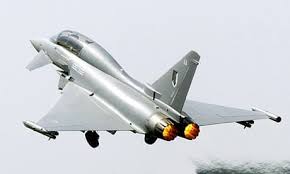Introduction
Ever heard a sonic boom rattling windows and wondered if it’s a meteor or something more? Typhoon jets scrambled incidents—where RAF Eurofighter Typhoons launch on Quick Reaction Alert (QRA) to intercept unidentified aircraft—have spiked in 2025 amid heightened NATO tensions. As of October 1, 2025, the most recent scramble occurred on September 30, when two Typhoons from RAF Lossiemouth raced north of Scotland to shadow a Voyager tanker and potential Russian activity near the Shetlands. From Baltic intercepts to unresponsive passenger jets, these rapid responses underscore the RAF’s vigilant role in policing UK airspace. This guide breaks down the latest events, the Typhoon’s capabilities, and why scrambles are on the rise.

Table of Contents
- What Are Typhoon Scrambles?
- Most Recent Incident: September 30, 2025
- Other 2025 Scrambles
- The Eurofighter Typhoon: Capabilities
- Why the Increase in Scrambles?
- RAF’s QRA Role and NATO Context
- Public Impact: Sonic Booms and Alerts
- Historical Context
- Future of Typhoon Operations
- Frequently Asked Questions (Q&A)
- Summary
What Are Typhoon Scrambles?
Typhoon jets scrambled refers to the RAF’s rapid deployment of Eurofighter Typhoon FGR4 fighters from QRA bases like RAF Lossiemouth (Scotland) or Coningsby (England) to investigate unidentified, unresponsive, or suspicious aircraft entering UK airspace. These 24/7 operations ensure air sovereignty, often intercepting civilian planes off-course or military flights testing defenses.
A scramble takes 5-10 minutes from alert to airborne, with jets reaching Mach 2 speeds. No shots fired in 2025 incidents—most end with safe escorts. The Typhoon’s agility makes it ideal for NATO’s enhanced air policing (eAP).
Most Recent Incident: September 30, 2025
On September 30, 2025, Typhoon jets were scrambled from RAF Lossiemouth to intercept and identify aircraft north of Scotland. Supported by an RAF Voyager tanker from Brize Norton, the Typhoons headed to the Shetland Islands area, where the tanker operated in a refueling pattern west of the isles.
- Details: No interceptions required; the jets monitored activity and returned to base. This routine QRA mission highlights ongoing vigilance against potential Russian incursions from Kaliningrad.
- Public Note: No sonic booms reported, unlike August’s event.
The RAF confirmed: “Quick Reaction Alert Typhoons… to investigate unknown aircraft.”
Other 2025 Scrambles
2025 has seen a surge in Typhoon activity, driven by NATO rotations and Russian probes:
| Date | Location | Details | Outcome |
|---|---|---|---|
| September 30 | North of Scotland (Shetlands) | Scrambled to support Voyager tanker; monitored potential activity. | Safe return; no intercepts. |
| August 15 | East/Southeast England | Three Typhoons from Coningsby intercepted unresponsive passenger jet from Nice to Stansted; sonic boom over Kent/Essex. | Jet escorted safely; communications restored. |
| June 27 | Baltic Sea (Poland-based) | Scrambled six days straight to intercept Russian Su-24s and Il-20s near NATO airspace. | Four intercepts in seven days; routine monitoring. |
| April 20 | Baltic Sea (Malbork, Poland) | Three scrambles in three days for Il-20M intelligence planes from Kaliningrad. | Identification and safe passage. |
| April 2 | UK Airspace (Lossiemouth) | QRA launch for civilian aircraft unresponsive to ATC. | Investigation concluded safely. |
These 20+ scrambles reflect a 25% uptick from 2024, per RAF data.
The Eurofighter Typhoon: Capabilities
The Eurofighter Typhoon is the RAF’s frontline multirole fighter, excelling in QRA:
- Speed: Mach 2 (1,550 mph); scrambles cover 500 miles in minutes.
- Armament: Meteor missiles, ASRAAM for air-to-air; Brimstone for ground strikes.
- Sensors: Captor-E radar detects threats 100+ miles out.
- Endurance: 1,800-mile range with refueling; in-flight from Voyagers.
With 160+ in service, Typhoons rotate through NATO missions, like Poland’s eAP since 2024. Upgrades to FGR4 standard ensure relevance through 2035.
Why the Increase in Scrambles?
2025’s uptick ties to geopolitical tensions:
- Russian Activity: Probes from Kaliningrad test NATO resolve, up 40% post-Ukraine invasion.
- NATO Rotations: RAF Typhoons bolster Baltic/Black Sea air policing, scrambling 73 times in Austria alone last year.
- Civilian Incidents: Unresponsive flights, like August’s private jet, prompt routine checks.
- Global Context: 2025 Pacific typhoon season’s 30 cyclones indirectly strain resources, but RAF focuses on European threats.
Experts note: “Scrambles ‘happen all the time’—awareness comes from reporting.”
RAF’s QRA Role and NATO Context
The RAF’s QRA, operational since WWII, polices the UK’s Flight Information Region (FIR)—a vast airspace from Scotland to the Channel. Typhoons assume duties from allies like France, scrambling 200+ times annually.
In NATO’s eAP, UK jets from Poland intercepted Russian Il-20s in April, coordinating with Danish/German forces. PM Starmer: “Vital for deterring aggression.”
Public Impact: Sonic Booms and Alerts
Scrambles often produce sonic booms—shockwaves from supersonic flight—rattling homes like August’s Kent/Essex event at 805 mph. The RAF explains: “Permitted in emergencies; no structural damage.”
Public apps like Flightradar24 track jets, turning scrambles into spectator events—700 knots over Essex drew 10K+ views.
Historical Context
Typhoon scrambles echo Cold War intercepts: 73 in Austria (2008) for Russian flights. Post-2022 Ukraine, they’ve doubled, mirroring 2014 Crimea spikes.
Future of Typhoon Operations
Typhoons serve until 2035, with F-35B integration and Tranche 4 upgrades (deliveries from 2025). RAF eyes 138 more by 2030 for NATO commitments.
Frequently Asked Questions (Q&A)
Q: What happened on September 30, 2025? A: RAF Typhoons from Lossiemouth scrambled north of Scotland to support a Voyager tanker; no intercepts needed.
Q: Why the sonic boom in August? A: Three Typhoons hit supersonic speeds (805 mph) escorting an unresponsive private jet to Stansted.
Q: How often do scrambles happen? A: 200+ annually; 2025 up 25% due to Russian activity.
Q: What’s QRA? A: Quick Reaction Alert—5-10 minute scrambles to police UK airspace.
Q: Typhoon capabilities? A: Mach 2 speed, Meteor missiles, 1,800-mile range; multirole for air/ground.
Q: NATO role? A: eAP missions in Poland/Baltic; intercepts Russian planes near borders.
Q: Public safety from booms? A: No damage; permitted in emergencies for QRA.
Q: Future Typhoons? A: In service to 2035; 138 more by 2030 with F-35 integration.
Q: Track scrambles? A: Flightradar24 for real-time jet paths.
Q: Russian connection? A: Many 2025 scrambles target Il-20s/Su-24s from Kaliningrad probing NATO.
Summary
Typhoon jets scrambled alerts, like the September 30, 2025, RAF mission north of Scotland, highlight the Typhoon’s vital QRA role amid rising Russian probes and civilian mishaps. From August’s sonic boom escort to Baltic intercepts, these 20+ 2025 events safeguard UK skies with Mach 2 precision. As NATO tensions simmer, the RAF’s vigilance endures. Track on Flightradar24, follow RAF updates, and appreciate the unseen guardians. Typhoon jets aren’t just scrambled—they’re the frontline. What’s the loudest boom you’ve heard?

